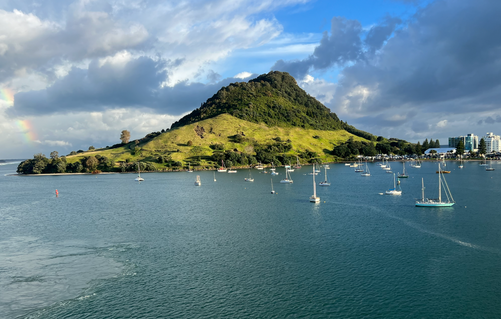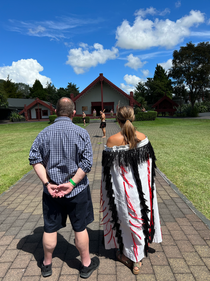Saturday, February 25th, 2023 Queen Victoria, Tauranga, New Zealand
Updated: Jul 4, 2023
This morning the Queen Victoria sailed into Tauranga; it was quite a tricky approach as the ship had to navigate between a small promontory on the port side and sandy shoals on the starboard side to enter the small bay. The promontory was dominated by Mount Maunganui, which at first looked like an island, but as we entered the bay, we could see the narrow connection to the mainland. Originally, we had booked a ships shore excursion for this stop, but a few weeks before we departed, the organizer of the Facebook group for the cruise, Gary Marsh, found an excursion by a private company that was better value – and so a bus full of us joined Gary on this trip. The itinerary included a visit to Rotorua, an area of natural beauty and much volcanic activity, and a tour of the local Māori cultural center. Our driver and tour guide met us at the port gates, and we boarded the small bus for our day’s excitement; soon we were off on our 7-hour excursion. The driver immediately started to narrate the journey, he was a wealth of information and started to explain how Tauranga was a high-end vacation destination for New Zealanders and as we drove along the coast road, heading out of town, he showed us the multi-million-dollar houses, many with their own unique story. We passed many fields planted with Kiwi Fruit, a major export of New Zealand. The driver explained how a teacher, back in 1902, had returned from a trip to China with some seeds; the plants really flourished in New Zealand and soon the “Chinese Gooseberry”, as it was known at the time, became very popular. After a few years, as the fruit became an important export crop, the name was change to Kiwi Fruit. The Kiwi Fruit grows on vines, but unlike grapes, the crop for the current year grows on lower vines while the vines for next year’s crop are raised up on wires. It’s a very strange looking arrangement. The landscape was very lush, they obviously get a lot of rain here, with rolling hills and, off in the distance, the occasional peak of a dormant volcano. The driver took the time to explain how there was no such thing as an extinct volcano After about an hour we made a short stop to view a waterfall in a damp forest; we could hear the distant screams of zip liners but couldn’t see them from our vantage point. The river that flowed over the waterfall was fed from a lake and the guide gave us the story of the Māori explorer who first ventured into this part of the land, naming the lake, and then travelling on to find a second lake, which he dutifully named Lake Two or Rotorua. The lake at Rotorua actually fills most of the caldera, the sunken peak of the previously active volcano. – there was also a small town in this beautiful area, a popular tourist destination. Te Puia is a Māori arts and crafts institute and the main destination for our trip today. The facilities are Te Puia all appear to be quite new and very well maintained, this is all tribal land and agreements between the various Māori tribes and the New Zealand government seem to be productive. Our small group of 21 were ushered into a waiting room with large screen displays of the various institute activities, the walls were also adorned with native artifacts. We were assigned a guide from the institute, and she soon arrived to explain the various events we’d experience, but first we had time for lunch, and she escorted us to the café. The food was very good; fresh-made sandwiches and savory pies – we sat under a large awning type structure that was open on two sides, the weather was mild, and a light breeze was blowing, it was very pleasant. The first part of our tour took us through the crafts institute; the tribe is focused on maintaining and passing down unique Māori crafting techniques, particularly for stone carving, weaving and wood carving. Scholarships are offered to a limited number of students from tribes across New Zealand – it was great to see and chat with amazing and enthusiastic students are they worked away at their craft. A small section of the institute is dedicated to the breeding of Kiwis, and we got a quick tour through the facility. Kiwis are under threat and so programs like the one at the institute are very important, the birds are nocturnal – living in burrows during the day and only coming out at night. From the totally dark viewing area it was extremely hard to see the birds in their enclosures, despite the guide pointing them out – no photos were allowed. The institute is located in an extremely active volcanic area and our tour included a visit to the mud pools and the geysers. The smell of Sulphur pervaded the air and the whole area was surrounded in steam clouds – the ground was hot to the touch. The geyser was continually giving off small bursts of steam, but in the time we were there it did not have a large eruption; unlike Old Faithful, this geyser does not erupt on a constant time cycle. The final part of our visit involved a performance of song and dance by the local tribe. A large meeting house was located at the back of a beautiful lawn area, the lawn was dissected by a straight path leading to the entrance of the house. A Māori lady emerged from the house and approached our group as we waited in the arched gateway; the lady explained the procedures that we were about to experience. We all lined up facing the house and our elected leader (Gary the tour organizer) stood six feet in front of us. Presented several warriors came out of the house along with a few more ladies, the warrior chief advanced down the path towards our leader, he made very aggressive movements and shouts, and brandished a sharp spear. The warrior chief laid a large leaf on the path and backed away, then our leader advanced to the leaf and, while maintain eye contact with the chief, stooped and picked up the leaf – he then walked backwards towards our line, all the time facing the chief. Thus we had indicated a friendly approach to this tribe, and we were invited into the meeting house with large whoops and screams. Once we were seated in the meeting house the whole Māori group put on a fantastic show of traditional singing and dancing; the highlight was the famous Haka war dance – it was brilliant. After a short visit to the gift shop, we rejoined our bus to take a quick tour through the town of Rotorua and down by the lake before we headed back to Tauranga. Back at the port we had enough time to walk into Tauranga and get a refreshing drink before boarding the ship to head for Bay of Islands.
That night we celebrated Sandra’s birthday with an excellent dinner at the onboard steak house, Verandah. Our friends Christine and Raymond joined us, and a good time was had by all.
What a fantastic day!



















































Comments